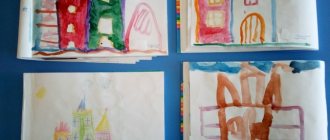Thematic planning of work on traffic rules in the preparatory group
Prospective - thematic planning for the prevention of children's road traffic injuries for children of the preparatory group “We know the rules of the movement, like the multiplication table”
September Topic “Know and follow traffic rules” Objectives:
— reinforce the rules of the street with children: know that people walk on sidewalks and cross the street at crossings when the traffic light signal permits;
children are not allowed to play near the pavement or on the sidewalk; transport drives on the right side of the pavement; know the purpose and signals of traffic lights; be able to determine by a traffic light signal in which direction the movement of vehicles and people is allowed. Joint activities of the teacher and children:
1. Targeted walk “The traffic light is our friend” 2. Conversation “Know and follow the traffic rules” 3. Drawing up a memo “Rules of conduct on the street that every pedestrian should know” 4. Work with the “Help” schemes the hero crosses the street.
Complete everything you need" 5. D/i "Smart traffic light" 6. P/i "Traffic light" 7. P/i "The fastest" 8. Story-role-playing game "On a city street" 9. Construction from waste material "Street" Independent activity of children:
1. Examination of illustrations.
2. Role-playing game “Transport”.
3. Drawing “I love riding a bike”
October
Topic “Why are road signs needed?” Objectives:
— to consolidate the rules of behavior on the street;
remember the famous road signs - pedestrian crossing; introduce new signs - attention, caution, children; — teach to understand and distinguish road signs intended for pedestrians and drivers; — develop the ability to react correctly to road signs; — develop the skill of conscious behavior on the road. Joint activities of the teacher and children:
1. Conversation “Why are road signs needed?” 2. Conversation “The history of the appearance of road signs in Russia” 3. Reading and learning the poem by Y. Pishumov “The city in which you and I live” 4. Making road signs movement 5. D/i “Road signs” 6. D/i “Guess which sign” 7. P/i – relay race “Public transport stop” 8. P/i “To your signs” 9. Entertainment “Travel around the country” road signs"
Independent activity of children:
1. Examination of illustrations.
2. Role-playing game “Transport”.
3. Drawing “Different cars driving down the street.”
November
Topic “Our village” Objectives:
- consolidate children’s knowledge of traffic rules;
introduce children to signs indicating pedestrian crossings; — expand knowledge about the rules of behavior for children on the street; — bring to the awareness of children what violation of traffic rules can lead to; — to cultivate in children attention, concentration, sensitivity, responsiveness, and the ability to help. Joint activities of the teacher and children:
1. Conversation “Streets of our village” 2. Conversation “History of the development of the village” 3. Making a time tape “Young village” 4. S/r game “Journalists” - “Interview - what do I know about my village » 5. Making a sketch map “My microdistrict” 6. D/i “Village Street” 7. Reading the story by V. Klimenko “Who is most important on the street” 8. P/i “Skillful pedestrian” 9. Training “First aid in case of injury."
Independent activity of children:
1. Examination of illustrations.
2. Role-playing game “Bus”.
3. Drawing “My favorite car that I would like to drive.”
December
Topic “Types of Transport” Objectives:
- consolidate the understanding of various types of transport (freight, passenger, air, water);
- generalize knowledge about the main types of ground transport (bus, trolleybus, tram, passenger car, truck): - consolidate knowledge about the main parts of the car (cabin, body, wheels, steering wheel); — introduce children to the rules of behavior at a passenger transport stop; — contribute to the formation of a culture of behavior in a public place. Joint activity of the teacher and children:
1. Conversation “Getting to know transport” 2. Walk to the stop “Observing urban transport” 3. Game “Find the mistake in the picture of transport with missing elements” 4. Drawing up a memo “Rules for using passenger transport” 5. Training “The Road to Kindergarten” 6.S/r game “Bus” 7.Competition of riddles about transport “Visiting Grandmother - Riddles”
Independent activity of children:
1. Story-role-playing game “Transport”
2. Drawing road signs.
January
Topic “The work of a traffic police officer” Objectives:
- to give a basic understanding of the work of a police officer, traffic police officer;
— explain the conditions under which their work is needed, talk about the meaning of the traffic controller’s baton and gestures. Joint activities of the teacher and children:
1. Meeting with a traffic police officer 2. Reading S. Mikhalkov “Uncle Styopa is a policeman” 3. Conversation “From the history of traffic lights and the appearance of traffic controllers on the streets of cities” 4. P/i “Gestures of a traffic controller” 5. Learning poems by S. Mikhalkov “My Street” 6. D/i “Highway” 7. Game situations “To whom and what do the signals say” 8. Reading by N. Nosov “Policeman” 9. S/r game “Policeman on duty” 10. Walk “Remember the traffic police rules.
These are your rules.” Children’s independent activities:
1. Examination of illustrations.
2. Thematic role-playing game “Road Rules”.
3. Coloring coloring books about transport.
February
Topic: “Types of intersections” Objectives:
- form ideas about the intersection;
— establish the rules for crossing the street at a pedestrian crossing; — consolidate the concepts of “pedestrian”, “sidewalk”, “roadway”, “pedestrian crossing”; — practice skills of moving through the roadway in accordance with traffic lights; — teach how to cross an intersection correctly, form a model of safe behavior at an intersection. Joint activity of the teacher with children:
1. Conversation on the topic “Crossroads” 2. Reading the poem “If you see a crossroads...” 3. P/i “Pedestrian crossing” 4. Solving a crossword puzzle with the keyword “crossroads” 5. Excursion to various types of crossroads 6. Game - training “Cross the Crossroads” 7. Solving problem situations “Violators” 8. Work with the layout “Crossroads”
Independent activity of children:
1. Examination of illustrations.
2. The plot-role-playing game “Tram”.
3. Collective application “Street of our village”.
March
Topic “Games in the yard” Tasks:
- discuss with children various dangerous situations that may arise when playing in the yard of the house;
— teach children the necessary precautions. Joint activities of the teacher and children:
1. Conversation “Games in the yard.”
2. Children's stories according to the plan - a diagram of how the children will play in their yard. 3. Children’s stories according to the plan - the “Safe route from home to kindergarten” scheme. 4.Reading V. Semernin “Forbidden - Permitted.” 5.Collective collage “Children’s games in the yard.” Independent activity of children:
1. Examination of illustrations of road signs.
2. Plot-role-playing game.
3. Compiling a story from personal experience “How to get from home to kindergarten.”
April
Theme “My friend is a bicycle” Objectives:
- introduce children to the rules of riding a bicycle;
— teach children the rules of behavior in various dangerous situations that may arise in urban conditions when children ride a bicycle; — promotion of knowledge on the rules of behavior on the roads; — to develop the ability to independently conduct search and research activities and present its results. Joint activities of the teacher and children:
1. Reading the poem by V. Kozhevnikov “My Car” 2. Conversation “Little cyclists” 3. Solving problem situations that arise when riding a bicycle.
Independent activity of children:
1. Examination of illustrations.
2. Thematic role-playing game “Road Rules”.
3. Coloring pages on the theme: “Road rules.”
May Topic: “We know the rules of the road, like the multiplication table”
Goal:
summarizing children’s knowledge of the rules of the road. 1.Viewing the training program “The ABCs of Safety” 2.Entertainment “Travel to the Land of Signography”
Independent activities of children:
1. Examination of illustrations.
2. Plot-role-playing game “We eat, eat, eat...”.
3. Drawing “Cars in the future.”
Preparatory group. Senior preschool age. Children 6-7 years old
Lesson summary for the preparatory group “Travel to the country of traffic” Lesson summary for the preparatory group Topic: “Travel to the country of traffic”
. Goal: - To bring to the awareness of children that in a big city all traffic - both cars and pedestrians - is subject to special traffic rules; — Remind the children of the rules for crossing the road...
ECD “In search of a road sign” for senior preschool age Direct educational activity “In search of a road sign”
as part of the implementation of a career guidance project.
Priority educational area: “Cognitive development”
Types of activities: cognitive, gaming, communicative, health-preserving. Age…
Summary of an educational conversation on traffic rules for children of the preparatory group of a preschool educational institution
Summary of an educational conversation on traffic rules for children 6-7 years old.
Topic: “You are a passenger!” Educator: - Guys, how did you get to kindergarten today? (children's answers) Educator: - Many of you are brought to kindergarten by your parents in cars. Educator: - How many of you parents have a seat belt or a child car seat in their car? (children's answers) Educator: - Do you use seat belts? (children's answers) Educator: - Why do you think seat belts are called that? Children's answers. (“They provide safety to people who drive in cars.”) Educator: - Think and tell me who should use seat belts in a car? Children's answers. (“Everyone who is in the car.”) Educator: — Raise your hand, those who always wear a seat belt in the car? — What can happen if a person does not fasten his seat belt? Answers-reasonings of children. Educator: - That's right: without a seat belt, a car passenger can fall and hit very hard and be injured. — Is there a child car seat in your car? (children's answers) - What is a car seat for? (children's answers) - Guys, a car seat that is installed in a car for transporting children is the only safe place for you. The official name for a child car seat is a “child restraint.” Standard car seat belts are designed for adults. Child car seats are intended for transporting children from birth to approximately 12 years of age (until the child reaches a weight of 36 kg or his height is more than 1.5 meters). Listen to the poems *** We have a miracle chair. This chair is simply awesome! Blue and red, and very safe. If I sit in it, Fasten my seat belts, We can drive easily, Good luck awaits us along the way. *** For little Sasha, If he is not in a chair, the ride is very scary and not interesting. If Sasha sits in a chair, then he is happy and brave. *** Safety is important: Get in the car - buckle up! Well, if you are a baby, sit in a car seat - It’s comfortable, it’s comfortable, It’s the safest. Now you can ride! Start your car! View an excerpt from the cartoon Road Watchers “I am a passenger!” Episode 6.
We recommend watching:
Summary of an integrated lesson on traffic rules for children in the senior group of a kindergarten. Summary of an integrated lesson on traffic rules in a kindergarten in the preparatory group. Summary of a lesson on life safety in the preparatory group. Reflective element Lesson notes on traffic rules for older preschoolers 5-7 years old
Similar articles:
Summary of a lesson on traffic rules in the preparatory group. Prohibition signs
Summary of a lesson on traffic rules in the preparatory group. Rules of conduct for pedestrians and drivers
Summary of a lesson on traffic rules in the preparatory group of a preschool educational institution. Pedestrians and transport
Traffic rules, traffic lights. Lesson notes - Notes of OOD in the preparatory group "Literate pedestrians"
Publication “Summary of educational activities in the preparatory group “Literate...” Purpose: Consolidating children’s knowledge about road signs. Program objectives: 1) expand and consolidate children’s knowledge about traffic lights and traffic rules; 2) remember the road signs with the children: – directional signs (“Pedestrian crossing”; “Underground pedestrian crossing”, –...
OOD on traffic rules “Safe winter road” in the preparatory group lesson on traffic rules “Safe winter road” Summary of the lesson on traffic rules “Safe winter road” Goal: instilling skills for safe behavior on the road in winter. Objectives: Educational: consolidate children’s knowledge about how traffic lights work, introduce them to the rules of safe behavior on...
Summary of OOD on traffic rules in the preparatory group “Learning the road alphabet” Goal: to consolidate and clarify children’s knowledge of traffic rules. Objectives: • Raising the desire of children of senior preschool age to comply with traffic rules. • Develop a sense of responsibility and independence when on the street and in transport. • Systematize children’s knowledge about the structure of the street,...
Summary of GCD on natural, social peace and safety in the preparatory group “Road Rules” Summary of GCD on natural, subject, social peace and safety in the preparatory group “Rules of the Road” Goal: to form ideas about the rules of the road. Introduce traffic rules, traffic lights, some road signs….






